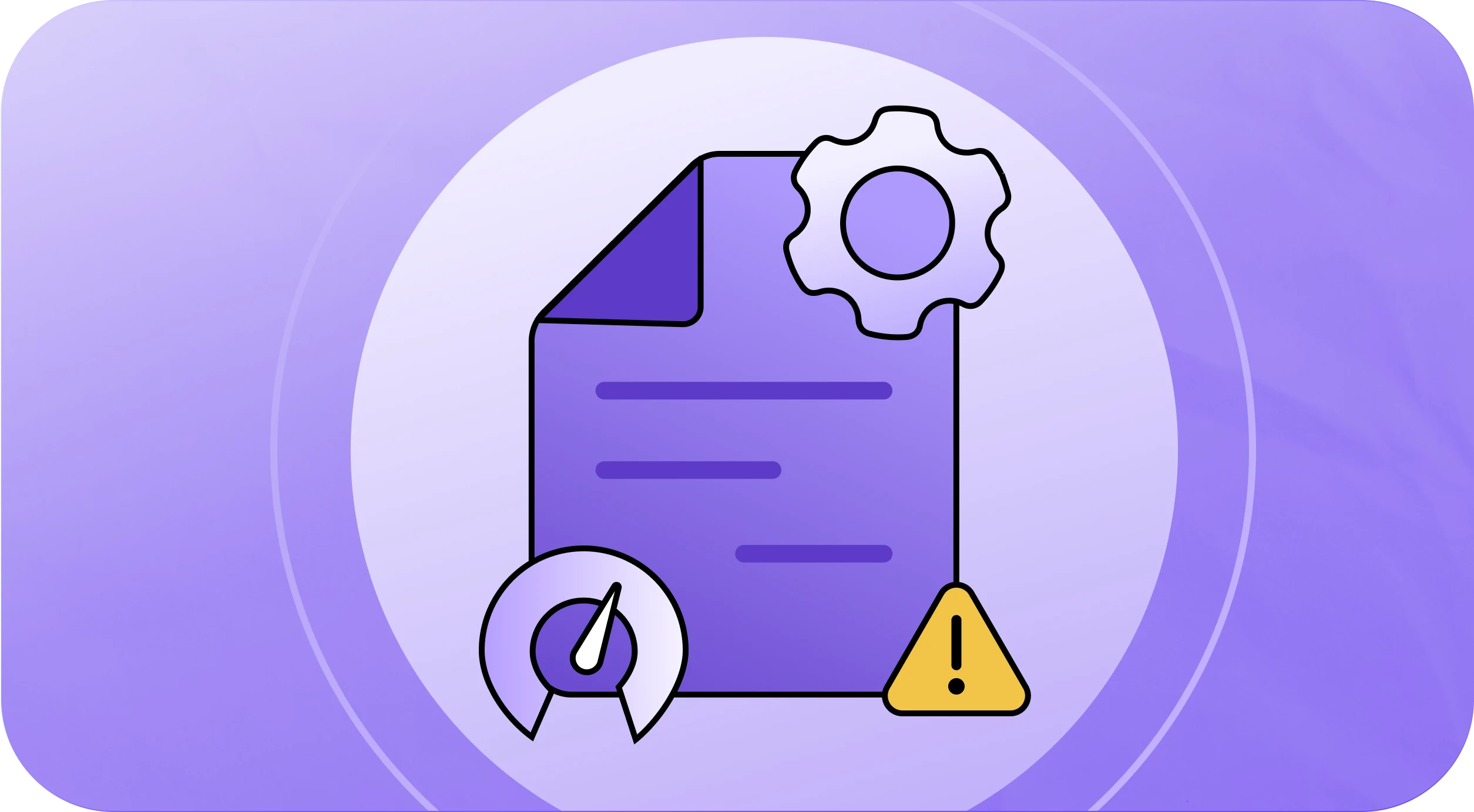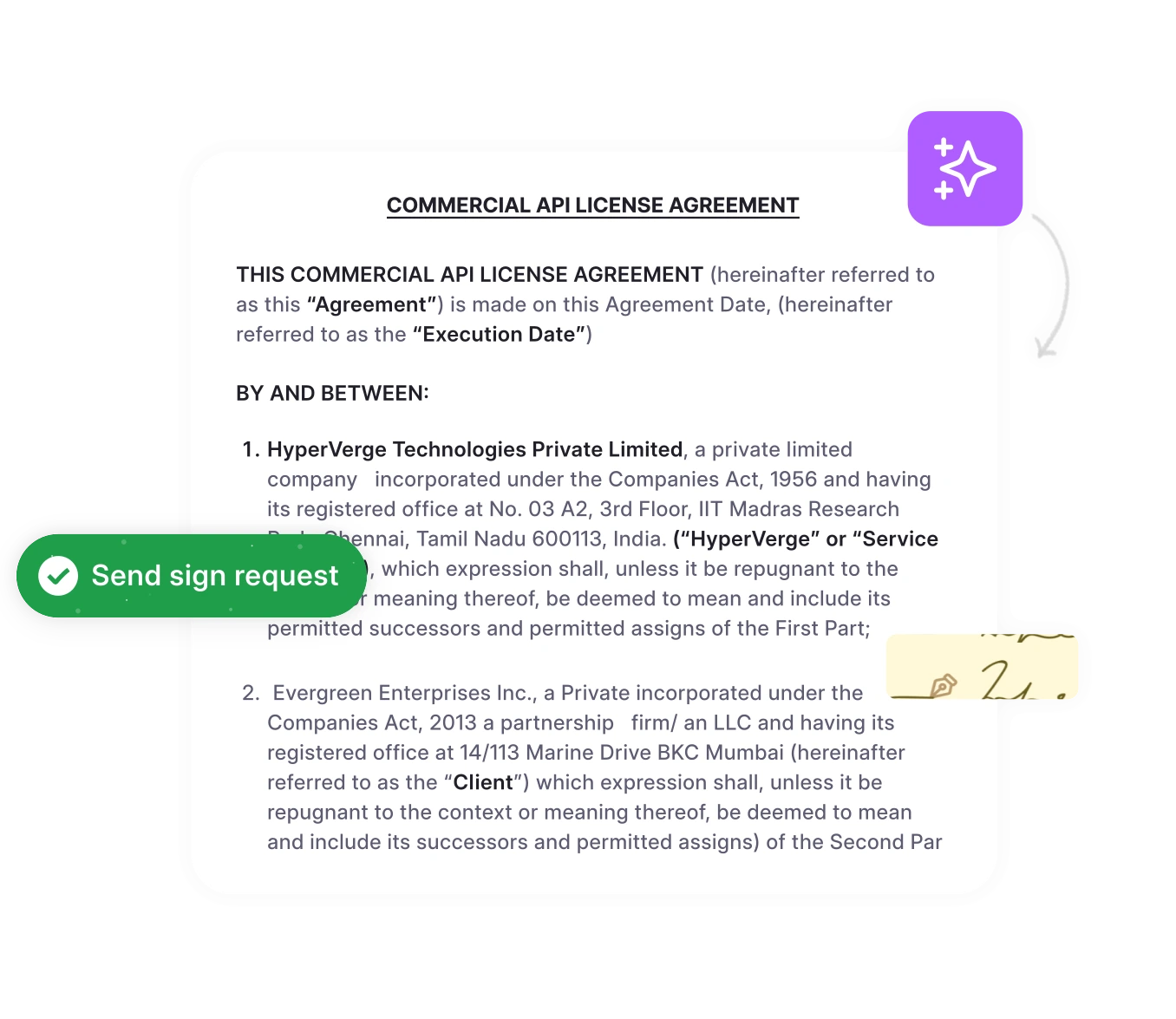At the heart of every successful vendor relationship sits a well-crafted vendor agreement that defines expectations and mitigates risk, forming a legally binding foundation for successful business transactions.
This guide breaks down vendor contracts into their core components. We’ll explore their strategic importance, essential legal provisions, and best practices for management, shortcutting your research so you can establish secure and productive partnerships.
Let’s dive in.
What is a vendor agreement?
A vendor agreement is a business contract that maps the business relationship between you and a vendor. It outlines deliverables, timelines, responsibilities, and legal protections that keep all parties aligned.
Key reasons you need one
Why every engagement with third party vendors demands a formal business contract:
Streamline your contract process
Bring clarity and automation to your entire contract lifecycle.
Book a DemoThe anatomy of a legally binding vendor agreement
Templates offer a starting point for the agreement creation process. Here are the ten essential components every vendor contract should include:
1. Covenants
This clause provides a detailed description of deliverables, timelines, milestones, and quality standards on the vendor agreement.
According to contract analysis guidance, covenants are promises made by each party about what they will do under the contract. A vendor typically agrees to provide specific goods or services, while the customer agrees to pay. The scope section transforms these promises from abstract commitments by each party involved into measurable obligations.
Best practice: Attach a statement of work as an exhibit that breaks down project phases, specific deliverables, and acceptance criteria in as much detail as possible.
2. How and when to pay
This clause eliminates ambiguity around financial obligations. Specify payment details:
- Total contract value or pricing structure (example: fixed price, hourly rate)
- Payment schedule (milestone-based, monthly, upon completed contract)
- Payment method and processing timeline
- Late payment penalties
- Sales tax responsibilities
- Any additional costs or reimbursable expenses
3. The exit
Every vendor contract is time bound. The term clause establishes, including termination clauses:
- Contract start and end dates
- Renewal terms
- Termination rights for both specified parties
- Notice periods and how to give such notice
- Early termination conditions and costs
This gives both parties a roadmap for dissolving the business relationship in time.
4. Confidentiality
This clause in the vendor agreement should define the confidentiality obligation:
- Contract start and end dates
- Renewal terms
- Termination rights for both specified parties
- Notice periods and how to give such notice
- Early termination conditions and costs
5. Promises made
Common vendor warranties include:
- Authority to enter the entire agreement
- Ownership or licensing rights for delivered work
- Compliance with applicable laws
- Professional standards and industry practices
- No infringement of third-party intellectual property rights
6. Who is responsible for what
The vendor’s liability is clarified here. The vendor might agree to indemnify you (or hold harmless) against:
- Third-party claims arising from their services
- Intellectual property infringement
- Data breaches caused by their negligence
- Bodily injury or property damage
7. Insurance cover
Specify minimum coverage requirements:
- General liability insurance
- Professional liability (errors and omissions)
- Cyber liability insurance
- Workers’ compensation
8. Benchmark performance
Laying out service level agreements, performance metrics, and remedies of the vendor agreement. Effective SLAs include:
- Specific performance metrics and reporting frequencies (uptime percentages, response times, delivery schedules)
- Minimum and maximum expectations for vendor performance
- Remedies for missing targets (credits, fee reductions, termination rights)
9. Ownership of work product
Address:
- Who owns deliverables created vendor pursuant to the contract
- License grants and rights to use
- Restrictions on use of the vendor’s products
10. Applicable laws
Specify:
- The governing law (which state or country’s laws apply)
- Where disputes must be filed
- The dispute resolution process (arbitration, mediation, litigation)
- Provisions for legal costs and attorney’s fees
Read also, A Guide to Supplier Contract Management
Common types of vendor agreements (+ applications)
How different contract types serve different business operations:
| Contract Type | Best For | Characteristics | Risks |
| Fixed-Price Contract | A well-defined product scope and project deliverables | Vendor agrees to complete specific work for a fixed price | Vendor bears cost overrun risk |
| Cash Reimbursable Contract | Where scope is uncertain | Client reimburses vendor for actual costs plus a fee | Client bears cost risk from market fluctuations |
| Time and Materials Contract | Flexible engagements or staff augmentation | Payment based on hours worked plus materials | Costs can escalate |
| Indefinite Delivery/Indefinite Quantity (IDIQ) | Ongoing services On-demand services over a set period | Establishes terms for services open-ended under a master agreement | Requires minimum and maximum order quantities |
Tip: Match your contract type to your risk tolerance. The more certainty you have about scope, the more you benefit from a fixed-price contract.
- To define the service scope, deliverables, and responsibilities before work begins
- To offer risk mitigation and legal recourse if things go wrong
- To benchmark vendor performance through service level agreements
- To protect parties and define payment terms, payment schedules, and extra costs
Streamline your contract process
Bring clarity and automation to your entire contract lifecycle.
Book a DemoManaging the vendor agreement lifecycle
Key considerations after the contract is signed
- Single source of truth: Store the signed PDF contracts in a searchable repository.
- Stakeholder collaboration: Notify relevant stakeholders on contract details around renewals, renegotiations, and extensions.
- Vendor onboarding: Schedule a kickoff meeting to review key terms, establish communication protocols, and clarify any ambiguous terms after vendor negotiations
- Performance tracking: Monitor vendor performance against SLAs, track deliveries, and document everything.
Qapita, for instance, uses a centralized CLM repository to track obligations across thousands of vendor contracts, cutting their contract turnaround time by 75% and eliminating missed renewals with automated AI alerts.
Automating vendor agreements for efficiency
Manual tracking of renewal dates, compliance obligations, and performance metrics doesn’t scale. When your organization manages dozens or hundreds of vendor contracts, spreadsheets fail. That’s where modern contract lifecycle management (CLM) platforms deliver measurable value.CLM software streamlines the entire process and standardizes contracts:
- Automated alerts: Never miss a renewal deadline or obligation milestone again
- Centralized repository: Search across all contracts for specific legal provisions or vendors
- Approval workflows: Route vendor agreements through appropriate signatories automatically
- Compliance tracking: Monitor adherence to applicable laws
- Analytics and reporting: Gain visibility into vendor spend, contract performance, and risk exposure
For teams drowning in PDFs of simple contracts, CLM platforms transform managing procurement contracts from an administrative burden into a strategic advantage. For example, LeadSquared automated their vendor agreement workflows with HyperStart, reducing contract review time from 4-6 hours to under 2 hours and managing a monthly volume of 180-250 contracts with a lean legal team business contract.
Parting thoughts
When properly crafted and actively managed, vendor agreements hold vendors accountable and create the groundwork for successful long-term partnerships and protect parties interests.
For organizations ready to transform vendor contract management from a compliance task into a competitive advantage, modern CLM technology offers a clear path forward.
Turn your agreements into assets
Don’t let renewals, obligations, and risks get lost in spreadsheets. Discover a smarter way to manage your vendor agreements.
Book a Demo










